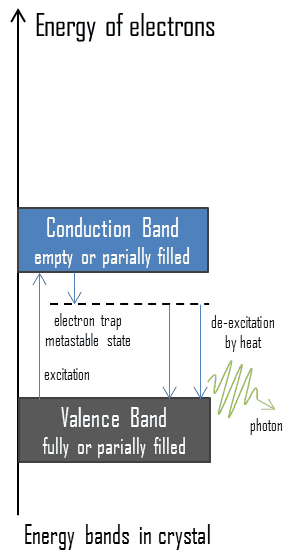 In general, thermoluminescence is a form of luminescence. It is exhibited by certain crystalline materials, such as calcium fluoride, lithium fluoride, calcium sulfate, lithium borate, calcium borate, potassium bromide, and feldspar. Previously absorbed energy from electromagnetic radiation or other ionizing radiation in these materials is re-emitted as light upon heating of the material. The material must also be transparent to its own light emissions.
In general, thermoluminescence is a form of luminescence. It is exhibited by certain crystalline materials, such as calcium fluoride, lithium fluoride, calcium sulfate, lithium borate, calcium borate, potassium bromide, and feldspar. Previously absorbed energy from electromagnetic radiation or other ionizing radiation in these materials is re-emitted as light upon heating of the material. The material must also be transparent to its own light emissions.
Materials – Thermoluminescence
The two most common types of thermoluminescent materials used for dosimetry are calcium fluoride and lithium fluoride, with one or more impurities (e.g. manganese or magnesium) to produce trap states for energetic electrons. The impurity causes traps in the crystalline lattice where, following irradiation, electrons are held. When the crystal is warmed, the trapped electrons are released and light is emitted. The amount of light is related to the dose of radiation received by the crystal.
Calcium fluoride TLD is used to record gamma exposure, while lithium fluoride TLD is used for gamma and neutron exposure (indirectly, using the Li-6 (n,alpha)) nuclear reaction. Small crystals of LiF (lithium fluoride) are the most common TLD dosimeters since they have the same absorption properties as soft tissue. Lithium has two stable isotopes, lithium-6 (7.4 %) and lithium-7 (92.6 %). Li-6 is the isotope sensitive to neutrons. In order to record neutrons, LiF crystal dosimeters may be enriched in lithium-6 to enhance the lithium-6 (n,alpha) nuclear reaction.
We hope, this article, Thermoluminescent Material – Types, helps you. If so, give us a like in the sidebar. Main purpose of this website is to help the public to learn some interesting and important information about radiation and dosimeters.